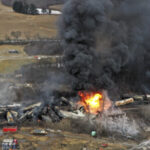The Federal Emergency Management Agency (FEMA) has committed initial federal funding of $151,000 to local governments in the declared counties of South Dakota for repairing damage to public infrastructure caused by severe storms and floods between May 28 to June 16, 2004.
“It is important to understand that when natural disasters overwhelm local governments’ abilities to cover the costs of recovery, there is a federal public assistance program in place to provide the necessary support,” Federal Coordinating Officer Justin DeMello said.
On July 20, President Bush declared the Rosebud Reservation and eight South Dakota counties federal disaster areas. The counties included Haakon, Jackson, Marshall, Mellette, Minnehaha, Todd, Tripp and Turner. On July 28 Yankton County was added to the declaration.
“I want to again thank President Bush for his support to South Dakota,” Governor Mike Rounds commented. “This money provides a real shot in the arm to those who need to get public infrastructure repaired before winter.”
Over the past two weeks, FEMA Public Assistance Coordinators (PACs) have held 40 briefings with local officials in all nine counties and the Rosebud Reservation. These PACs have been documenting damage and estimating repair costs.
“Our coordinators continue to hold briefings, inspections and writing up project worksheets for damaged roads, facilities, and structures in all the declared areas,” DeMello said. “Our goal is to have all inspections finished by the end of August.”
FEMA’s Public Assistance program funds 75 percent of reimbursements to local entities, while 25 percent of non-federal costs are divided among state and local governments. Disaster officials have estimated that the total federal and state disaster aid to local governments here will eventually approach $1 million.
Such eligible reimbursement costs may include debris removal; immediate protective measures, including overtime pay for emergency workers; repair of roads and bridges; repair of water control facilities; repair of public buildings and equipment; repair of public utilities; and repair of recreational facilities such as parks.
Was this article valuable?
Here are more articles you may enjoy.

 Viewpoint: Striking Risk-Reward Balance for Shipping Lithium-Ion Batteries
Viewpoint: Striking Risk-Reward Balance for Shipping Lithium-Ion Batteries  Vintage Ferrari Owners’ Favorite Mechanic Charged With Theft, Fraud
Vintage Ferrari Owners’ Favorite Mechanic Charged With Theft, Fraud  Norfolk Southern to Pay $600 Million to Settle Ohio Spill Case
Norfolk Southern to Pay $600 Million to Settle Ohio Spill Case  Inflation Contributes to Rising Loss Costs for US Commercial P/C Insurers: Fitch
Inflation Contributes to Rising Loss Costs for US Commercial P/C Insurers: Fitch 